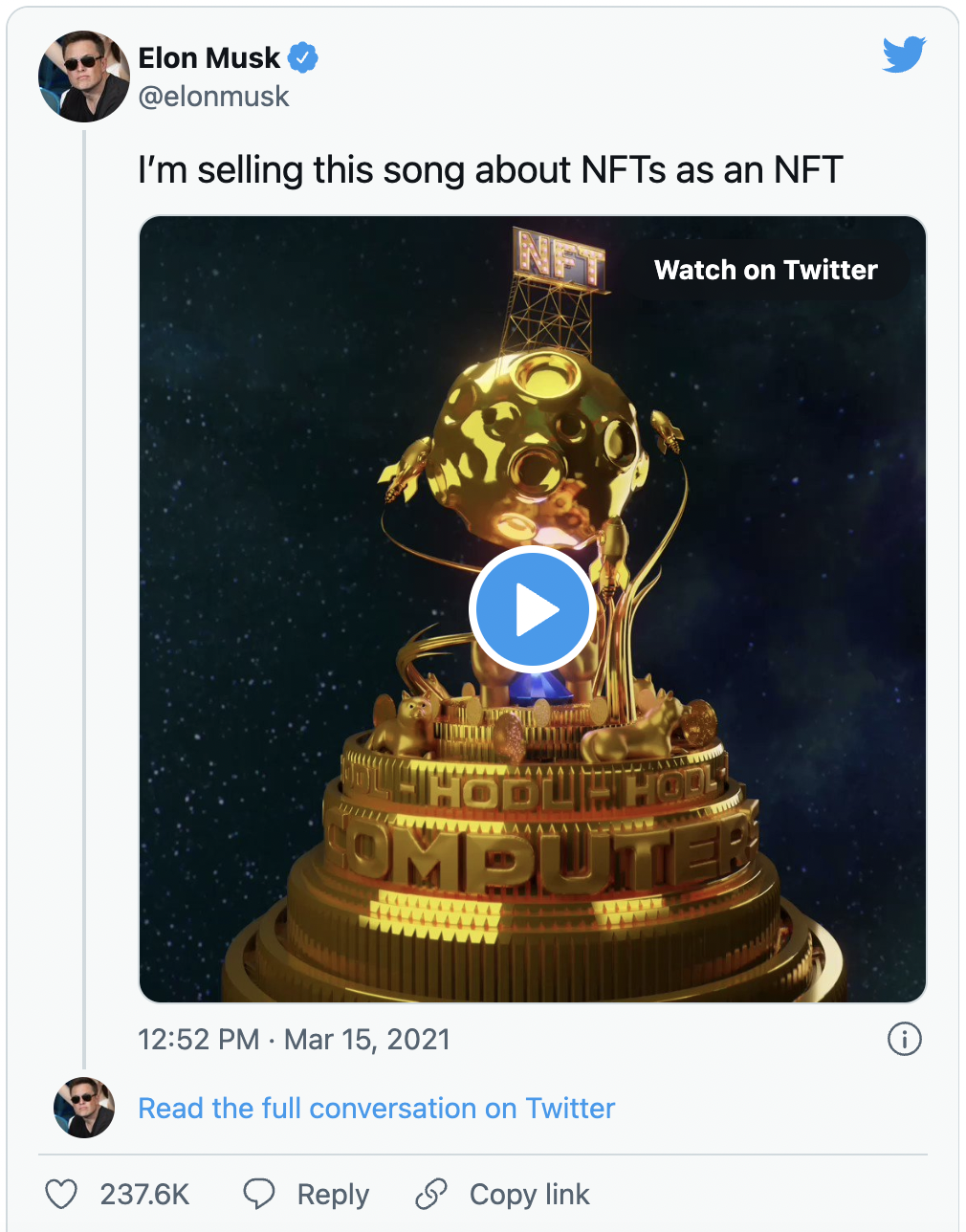10-Minute Crash Course on NFTs
10 minHey friends, Anusha here!
At this point in April 2022, you have probably heard of, read about, or had conversations about NFTs. With every passing month, NFTs and the cryptoworld seem to be creeping more and more into music-centered conversations. But if you were like me, the term “NFT” was more of an ambiguous buzz word than a meaningful concept that I understood. Once I joined RRA and started digging more into music business, I realized how much of a disruptor NFTs are and I wanted to share what I uncovered about it. Let us know your thoughts and happy reading!
Disclaimer: this article includes my editorial thoughts, as well as some data I've gathered throughout my research. All of my sources are linked at the bottom of this page. Moreover, nothing in this article is or should be construed as investment or legal advice. This article is written purely for entertainment purposes only.—
What is an NFT?
NFT is an acronym that stands for Non-Fungible Token.
NFTs are unique and unreplicable pieces of art. A few examples of music-related NFTs include: cover art, song, remix, sheet music, etc.
They are typically sold in limited quantities or for limited amounts of time.
NFTs derive value from the media they represent - they’re considered to be collectible items that can gain in value.
When NFTs first came out on the scene, the main application was for digital art or purely visual mediums. As the technology and awareness became wider, the applications for NFTs also increased. When it comes to music, artists are able to create an NFT out of anything: cover art, mp3/wav files of songs (full, instrumentals), concert tickets, backstage passes, virtual merchandise, etc. A few attractions for artists to get into the NFT space are 1) artists are able to sell directly to fans and eliminate some of the middle layers and 2) artists can get a royalty each time a NFT collectible they originally set up get’s resold.
2. How do NFTs work and what is their association with cryptocurrency?
NFTs are bought and sold using blockchain technology.
Proof of ownership of an NFT is determined by using each cryptocurrency’s blockchain technology. Blockchain is a “shared, immutable ledger that facilitates the process of recording transactions and tracking assets in a business network.”
There are dozens of NFT marketplaces. The largest marketplace is OpenSea - which uses Ethereum, a type of cryptocurrency.
Solana is the other cryptocurrency that is making headway in this space because it is more sustainable to the environment.
Cryptocurrency value changes over time.
Other notable NFT marketplaces include Binance, Rarible, Sing Market, Audius, Sound.xyz, Nifty Gateway, and NBA Topshot. More NFT marketplaces keep popping up as this is a highly evolving space.
In order to purchase a NFT, a patron must have a crypto wallet (like a Coinbase Wallet or MetaMask)
Validity of ownership is determined through some form of proof. The type of proof varies by cryptocurrency:
Proof of Work - uses large amounts of energy; corresponding currency: Etherium
Proof of Stake - uses small amounts of energy; corresponding currency: Solana
NFTs and cryptocurrency go hand in hand, and it is impossible to use dollars to directly purchase a NFT. So if you want to get in the game, consider the following steps:
Research a crypto-wallet for you and consider whether to invest/transform your dollars into a cryptocurrency like Etherium or Solana.
Research NFT marketplaces and see what currencies they transact on.
3. NFTs can literally be anything
Here are some examples of NFTs that music professionals (artists, producers, songwriters) have been making:
Songs (unreleased or released) in forms of : WAV, MP3, instrumental versions, stems, DAW session files, etc
Cover Art : jpeg or png file, animated, 3D, interactive, etc
Videos : exclusive video content
Metaverse avatars
BTS footage, imagery
Lyric sheets
Beats
Virtual or physical merch
Tickets: concert, meet and greet, classes, etc
When doing this research, I was stunned as to how many different things can be considered or made into an NFT. Truly the possibilities are endless. So if you’re an artist or creative looking to create an NFT to sell to your audiences, there are honestly a lot of creative things you can choose to sell!
Steve Aoki collaborated with Antoni Tucci to create a debut NFT collection for $4.25 million.
4. If you’re interested in creating an NFT, you need to know:
You can mint, aka create, a NFT on the following marketplaces:
Opensea: any NFT, no gatekeepers
Rarible: art and photography
Nifty Gateway: popular for celebrity or expensive NFTs
Binance: images, video, or audio
Catalog: offers artists 100% of sales, growing popular in music industry
Async Music: Stem NFTs
Audius: centralized version of Spotify based on Etherium and Solana
Outside of creating the NFT asset itself (audio, video, file, image, etc), there is a “gas fee” cost to mint an NFT.
Gas fee refers to the energy cost to mint the NFT.
Depending on the way it is set up, the gas fee can either be paid by the minter (aka the artist putting it out) or the buyer (aka the patron choosing to purchase the NFT)
The other leg work required to mint a NFT is includes creating the right terms, payouts, rules, royalty structure, etc. Essentially a contract needs to be made.
According to Queue-it blog, here are the 9 steps it takes to really set up a successful NFT drop:
Looking into this world, there are truly so many ways to mint an NFT. Someone could decide to mint a low quality selfie as an NFT if they really wanted! Outside of the legwork/set up required to get into the NFT game (aka buying and selling NFTs), it would be advantageous for artists to determine what the demand would be for said NFT. Artists probably have to be willing to invest some of their own money into a cryptocurrency, invest some time to create the right contract, and market their NFT in a smart way so that they can create some buzz and ideally sell out of their NFT when they launch! If said artists are like me and are concerned about the sustainability of NFTs but also want to reach the large audience of OpenSea, they can find solace that OpenSea is working on integrating Solana into their system.
Some other tips that I’ve put together based on research and observations from my friends’ NFT drops to ensure a successful NFT drop:
Start with a small NFT drop and scale larger each time. You’d rather sell out in your first drop in a short amount of time than have a large quantity of NFT that does not sell right away.
Hype is reallllly big part of this culture - be ruthless and persistent in how you market your NFT.
Dropping an NFT is very similar process to dropping music (or singles) in the digital world we live in.
Successful artists engage with their channels in an especially consistent way - they become a storefront and connect with their customers on a high level.
—
Overall, my belief is that NFTs are a great way to connect with your audiences and have them feel like they’re more invested in your world as an artist. NFT’s can give your audience and fans an opportunity to feel ownership in your world and maybe even a way for them to make their own money off of you as you increase in value! It’s a way to really “timestamp” your fans from Day 1’s to Day 100’s!
Minting and creating NFTs can really push your brand to a new level. It’s up to you as an artist or music professional to decide if the investment in this disruptor at this point is something that aligns with your brand values. My personal opinion is that crypto, NFT, and the blockchain technology are only going to continue to grow in the spaces of art and music. I myself am brainstorming and strategizing the ways I may leverage or create an NFT in the near future! I will keep you posted on my journey and would love to hear from you on your experiences with NFTs (having either purchased or minted them yourself), and if you have any tips that we should incorporate!
Until next time!
~ Anusha Savi (Anusha Suresh)
Disclaimer: this article includes my editorial thoughts, as well as some data I've gathered throughout my research. All of my sources are linked at the bottom of this page. Moreover, nothing in this article is or should be construed as investment or legal advice. This article is written purely for entertainment purposes only.Sources:



